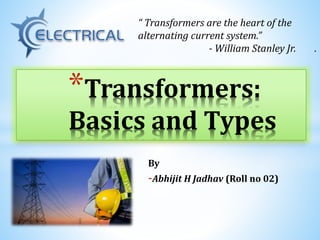
Transformer 161127050149
- 1. By -Abhijit H Jadhav (Roll no 02) *Transformers: Basics and Types “ Transformers are the heart of the alternating current system.” - William Stanley Jr. .
- 2. * Overview Need of transformer Introduction History Principle Construction and Working Types of transformers Applications Auto transformer Bibliography
- 3. * Need of transformer In most cases, appliances are manufactured to work under some specific voltages. Transformers are used to adjust the voltages to a proper level. The transformers are the basic components for the transmission of the electricity. Transformer is used to increase the voltage at the power generating station(Step up) and used to decrease the voltage(Step down) for house hold purpose. By increasing the voltages the loss of the electricity in the transmission purpose is minimized.
- 4. * Introduction Transformer is a static device. It transfer electrical energy from one part of the electrical or electronic circuit to other part of circuit without changing the frequency. It works on the Michal Faradays law of Electromagnetic Mutual Induction.
- 5. * History The first transformer was developed by Ottó Bláthy, Miksa Déri, Károly Zipernowsky (Z.B.D Transformer) in 1885. Further In 1885 William Stanley makes the transformer more practical due to some design changes and developed a three phase transformer. The design of William Stanley was first commercially used in the U.S.A in 1886.
- 6. * Principle * It works on the principle of Electromagnetic Mutual Induction. Electromagnetic Mutual Induction: When the current is provided to the Primary Winding it behaves as electromagnet due to this the EMF is induced in the Secondary winding as it comes in the area having magnetic field lines due to primary Winding. Vs = Ns.dΦ/dt Vs = Secondary Winding Voltage Ns = Secondary Winding Turns .
- 7. * Construction • Cores are designed not to have current in it. But still there is a leakages current Or the eddy current present in it. To minimize these current the cores are laminated. Laminated Core • Made up of copper or aluminum coated with very thin layer of insulation. Winding • The main function of conservator tank of transformer is to provide adequate space for expansion of oil inside the transformer. It is usually Cylindrical or cubical. Tank • It is provided by using Synthetic Oil between Core and Tank. Isolation • When the temperature changes occur in Transformer insulating oil, the oil expands or contracts and there an exchange of air also occurs when transformer is fully loaded. When transformer gets cooled, the oil level goes down and air gets absorbed within. Breather
- 8. * Types of Transformers Transformer Basis of Construction Core type transformer Shell type transformer Spiral core transformer Basis of Winding Step up transformer Step down transformer Isolation transformer Basis of coolant material used Oil filled self cooling Oil filled water cooling Air blast
- 9. * Basis of construction Core type transformer: Its core has two limbs .The windings are wounded on two limbs of the core material. Shell type transformer: Its core has three limbs and two windows. Both the windings are wounded on the central limb.(one over the other) Spiral core transformer: The core constructed is similar to wheels of spokes. The windings are wounded these spokes like structure.
- 10. * Basis of Windings * Step up Transformer: The no of windings on Primary side is less than the no. of windings on the secondary side. Np < Ns * Step down Transformer: The no. of winding on Primary side are more than the no. of windings on the secondary side. Np > Ns * Isolation Transformer: The no. of winding on Primary side are equal to the no. of windings on the secondary side. Np = Ns
- 11. * Basis of coolant *Oil filled self cooling: Oil filled self cooled type uses small and medium-sized distribution transformers. The assembled windings and core of such transformers are mounted in a welded, oil-tight steel tanks provided with a steel cover.. The oil helps in transferring the heat from the core and the windings to the case from where it is radiated out to the surroundings. *Oil filled water cooled: This type is used for much more economic construction of large transformers. The cooling coil is mounted near the surface of the oil, through which cold water keeps circulating. This water carries the heat from the device. *Air Blast: This type is used for transformers that use voltages below 25,000 volts. The transformer is used at houses.
- 12. * Applications 1. Transmitting electrical energy over long distances through wires. 2. Transformers with several secondary's are used in television and radio receivers where several different voltages are required. 3. Used as voltage regulator 4. Used almost everywhere in day to day life.
- 13. * Auto Transformer The autotransformer has only one winding. The winding is common to both the primary and the secondary one. The working principle is same as that of normal transformer difference is that it has one winding divided into primary and secondary. Advantages: Less costly Better regulation Low losses as compared to ordinary two winding transformer of the same rating. Disadvantages; An autotransformer does not provide electrical isolation between its windings.
- 14. The secondary winding is not insulated from the primary winding. Used only in the limited places where a slight variation of the output voltage from input voltage is required. Applications It is used as a starter to give upto 50 to 60% of full voltage to the stator of a squirrel cage induction motor during starting. It is used to give a small boost to a distribution cable, to correct the voltage drop. Changing fan speed over a narrow range.
- 15. www.wikipedia.org/wiki/transformers www.cnet.com/transformers www.electricalengineeringinfo.com/transformers www.electrical4u.com/transformers www.electronics-tutorials.ws/transformers